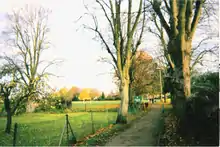Easington, Cherwell
Easington, Poets Corner and the Timms estate are three interconnecting estates in the town of Banbury, Oxfordshire.


History
Easington proper
Easington is a ward and former Mediaeval village in the south-west of the market town of Banbury. Easington, which was a rural estate attached to the former Calthorpe Manor, was first mentioned in 1279. Its demesne lands were subsequently leased out over the years.[1]
In 1505 the Easington estate was leased out for a rent fee for 15 years to Anne, the relict of the lord, Sir William Danvers and after her death in 1520 a new lease for 40 years was made to the local mercer, William Pierson. Laurence Pierson was farmer of Easington from 1540 to 1541 and by 1545 the lease had family passed to John Crocker of Hook Norton, to hold let his son-in-law Edward Hawten use it for a rent. The Bishop of Lincoln's vast Banbury estate, except for Neithrop and Calthorpe, was sold to the Duke of Somerset in 1547, but by 1550 he granted it (except for of Hardwick) to John Dudley, Earl of Warwick, then the Duke of Northumberland shortly afterward, who in 1551 granted it to the Crown in exchange for other lands. After 1551 the lordship of Easington seems to have remained with the Crown as no one took up the rent or apparently owned the letting rights.[2]
The Barber family were local landlords, who let out their Easington estate's lands, examples being Little Wood close was leased to a local man in 1690, the adjacent lands in Berrymoor to another in 1692, and some 16 acres in Farm Field to yet another in 1691. by 1728, the Berrymoor lands were leased along with the first Berrymoor Farm, and some 30 acres of land along with and ½ yard land in Farm Field to the same owner. As of 1734, a large portion of the estate (including Easington Farm and 93 acres of arable land) was leased to a local man, in 1760 a further 30 acres were included in the lease lands of Easington Farm, and in 1787 the whole lease lands of 147 acres of the adjacent Farm field and several village closes were included in the deal from 1799 onwards. The Barber family's property in Easington was thus farmed as a whole by successive tenants until late Victorian times.[1]
The longstanding Easington Farm's buildings was extensively repaired and enlarged in 1793 by the then lease holder[2]
Banbury town council built the houses in King's Road and on the Easington estate at the time and other working-class type houses were built at the south end of Britannia Road and the area to the east between 1881 and 1930, and also in both Old Grimsbury Road and Gibbs Road in Grimsbury, and more up-market houses were built in both the Marlborough Road area and in Bath Road, Kings Road, Park Road, and Queen Street in Neithrop.[1][3]
Ordnance Survey maps from 1882, 1900 and 1922 show that the houses on Broughton Road are built over an old claypit call the Bear pit. Berrymoor farm, whose last land lease was of mid Victorian origin, had become a laundrette by 1922 and had lost 2 outhouses, but gained a small annexe to the main building.
The 1919 Housing Act was followed by the building of the Easington housing estate of 361 council houses in what was one of the first slum clearance schemes in the country. By 1930 the by now medical officer reported 131 Banbury town centre houses unfit for habitation. So in 1933 Banbury council opened the Ruscote housing estate of 160 houses. The heavy increased population between 1931 and 1949 was accommodated by the expansion of the town in three main areas, in each of which houses were built both by the town corporation and by housing private companies. The three areas were between the Oxford and Bloxham roads, where about 500 houses were built before 1939 to form the bulk suburb of Easington; in the area of the older village and suburb of Neithrop, where before 1939 some 500 houses were built both around the earlier houses and further west in new streets on either side of the Warwick road, a development which was extended to the south-west after 1945.[1][3] Most of the estate was built in the 1930s and 1940s as local industry began to grow, with a large expansion in the early 1960s, due to London overspill.
The land south of the Foscote Private Hospital in Calthorpe, Oxfordshire and Easington farm were mostly open farmland until the early 1960s as shown by the Ordnance Survey maps of 1964, 1955 and 1947. It had only a few farmsteads, the odd house, an allotment field (now under the Sainsbury's store), and the Municipal Borough of Banbury council's small reservoir just south of the then 150-year-old Easington farm and a water spring lay to the south of it.
Berrymoor farm was finally demolished in circa 2004 after many years of dereliction had made it unsafe to use and became today's St. Mary's View. Much of the farm land was used to build a children's day-care, an industrial storage facility, a small electrical substation, and a branch of De Montfort University (now a branch of the Oxford and Cherwell College) on in the late 1960s.
The Timms and Poets Corner estates
Two minor streams once ran from a spring near the allotment gardens and the land under today's Timms estate. An old clay pit, kiln and brick works lay near the Poets Corner estate. The pit was of mid Victorian origin and the buildings were put up by the issuing of the 1881 O.S. map. The pit had been filled in by the 1920s, the buildings closed by the 1940s and the site built on by the late 1960s as shown by the Ordnance Survey maps of 1964, 1955 and 1947.

The Timms estate and Poets Corner estate were built in the late 1950s and early 1960s respectively. Poets Corner actually covers the site of an old sporting rifle range, which went out of use when the army left just after the Second World War. The Timms estate[4][5] and Poets' Corner estates[6] are also part of the ward which contains many new-style homes. The A361 and A4260 roads pass adjacent to the estate.
The people living in the 3 estates are generally more upper class in orientation, higher up on the social ladder and tend to have managerial rather than manual or retail jobs. The Easington and Timms estate has only a few recent overseas immigrants, most of which are either Irish, Poles or Czechs. The Cherwell Heights and Poets Corner estates tend to slant towards South Africans, Brazilians and Irish.
Local amenities
Easington has a public house called The Easington,[7][8] some convenience shops and numerous other local amenities including a sports field. The Timms estate has some parks and a shopping complex, while the Poets Corner estate has a major park and a small convenience store.
Local politics
Easington ward is customarily Conservative and stayed Conservative during the 2006 local elections for Cherwell District Council, but the ward had changed to one Labour councillor and one Conservative Party councillor in the previous election of 2002. The Green party candidate lost in 2006. The Conservatives still hold Easington ward for the Banbury Town Council and Oxfordshire County Council.
The Liberal Democrats and UKIP fielded no candidates in the ward during 2006. A lone Liberal Democrat stood in the Hardwick estate only.
Schools
Two of Banbury's biggest secondary schools and one primary school are in Easington:
- Banbury School
- Blessed George Napier Roman Catholic School[9]
- Harriers Ground Primary School
- Queensway Primary School on Brantwood Rise.
Banbury School is a mixed, multi-heritage, fully comprehensive school with 1650 students (including sixth form) situated on Ruskin Road, in the Easington ward of Banbury, Oxfordshire, England. The school is a specialist Humanities College.
Sport and leisure
Easington has a non-League football team Easington Sports F.C. who play at Addison Road.
Recreational areas and parks

- The Easington Recreation Ground is the estate's principal park and recreational area.
- The Browning Road Park and the well-resourced Browning Road Children's Play Area are about 1⁄3 the size of Easington Recreation Ground and is the main park and children's play area in Poets Corner. It is rather prone to winter flooding since a spring and minor stream was poorly culverted there in the early 1970s.
- The Brantwood Rise Park is a small piece of parkland in the Poets Corner estate. It is fenced in by residents' gardens' fences, save for the small lane running through it. It is merely approximately 25 ft x 12 ft. It has 1 bin, 5 trees and a bench. The kids' swing was removed in 2004, due to vandalism.
There are also 2 minor play parks and one minor park, the biggest of these being on the Timms estate, by the local shopping complex.
Transport

The local bus services to Banbury town centre via Calthorpe and the Timms estate are run by the Stagecoach Oxfordshire bus company. Heyfordian Travel buses also run a limited service on weekdays to the Timms estate and on weekdays and Saturdays to PoetsCorner via Bretch Hill.
Gallery
 A park in Easington estate, Banbury, in 2001.
A park in Easington estate, Banbury, in 2001.
References
- "Banbury – Economic history | A History of the County of Oxford: Volume 10 (pp. 49–71)". British-history.ac.uk. 22 March 1923. Retrieved 16 March 2014.
- "Banbury – Manors | A History of the County of Oxford: Volume 10 (pp. 42–49)". British-history.ac.uk. 22 June 2003. Retrieved 16 March 2014.
- "Banbury – Local government | A History of the County of Oxford: Volume 10 (pp. 71–89)". British-history.ac.uk. Retrieved 16 March 2014.
- "Property for sale in Banbury". uk: Nestoria.co.uk. Retrieved 16 March 2014.
- "Banbury bungalow – Trovit". Homes.trovit.co.uk. Retrieved 16 March 2014.
- "Connells, OX16 – Property for sale from Connells estate agents, OX16". Zoopla. Retrieved 16 March 2014.
- "Hungry for good pub food at The Easington in Banbury?". Emberinns.co.uk. Archived from the original on 16 March 2011. Retrieved 16 March 2014.
- "LABOUR’S MANIFESTO TO PROTECT LOCAL PUBS « Grahame Morris for Easington". Archived from the original on 11 July 2011. Retrieved 16 March 2014.
- School website